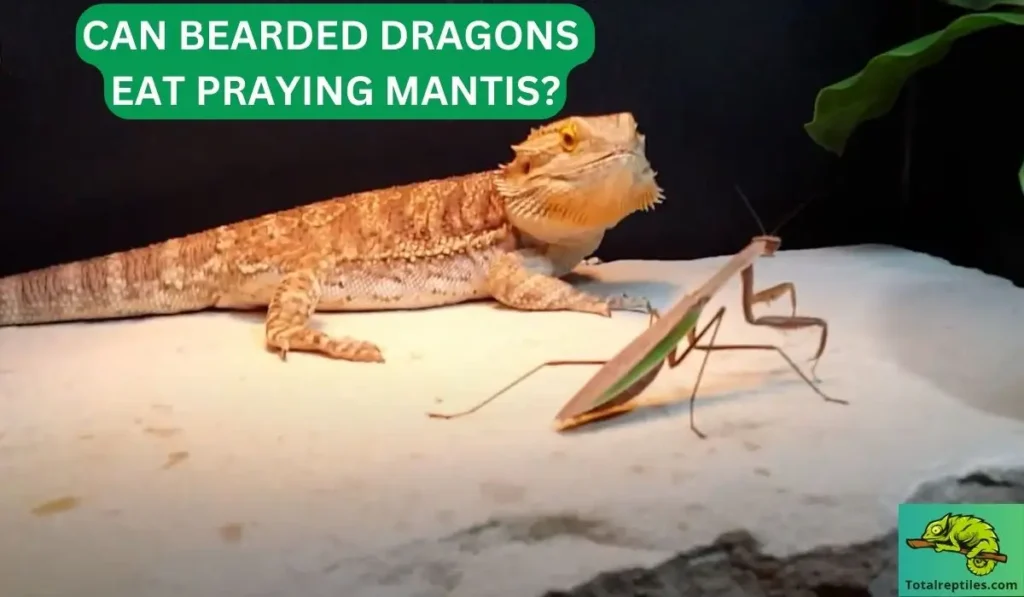Ok, I am going to give you the answer here.
While these intriguing insects are indeed edible for bearded dragons, not all mantises suit their dining pleasure.
One crucial aspect to bear in mind is the size and temperament of these creatures. Praying mantises can grow considerably and exhibit aggressive behavior, which might challenge your lizard. The spiked legs and assertive nature of mantises could potentially intimidate bearded dragons.
But, if you’re determined to offer praying mantises to your bearded dragon, opt for properly farmed mantises from reputable pet stores to ensure their safety and enjoyment.

Bearded Dragons Eat Praying Mantises – Potential Benefits and Risks
Before introducing praying mantises as part of your bearded dragon’s diet, it is essential to consider the potential benefits and risks involved. Let’s explore this intriguing topic in more detail.
Benefits of Bearded Dragons Eating Praying Mantises:
Nutritional Variety: Praying mantises offer a different nutritional profile than other insects commonly fed to bearded dragons. They are a good source of protein, which is essential for your dragon’s growth and overall health.
Below is a table highlighting the nutritional value of praying mantises, showcasing the essential components they provide for bearded dragons’ diets:
| Nutrient | Amount per 100g |
| Protein | 15g |
| Fat | 6g |
| Calcium | 30mg |
| Phosphorus | 70mg |
| Vitamin A | 2000 IU |
| Vitamin C | 8mg |
| Vitamin E | 2mg |
Praying mantises are a rich source of protein, which is necessary for muscle development and growth. They also contain beneficial fats, calcium, phosphorus, and various vitamins.
Incorporating praying mantises into a bearded dragon’s diet can contribute to a well-rounded nutritional intake, supporting overall health and vitality.
However, remember to consider the appropriate size and potential risks associated with feeding mantises, as mentioned earlier.
Enrichment and Mental Stimulation: Introducing new prey items like praying mantises can provide mental stimulation and enrichment for your bearded dragon. The challenge of capturing and consuming a unique insect can mimic their natural hunting instincts.
Risks and Considerations:
Size Disparity: Praying mantises can grow significantly, making it challenging for bearded dragons, especially hatchlings or smaller individuals, to consume them. It is crucial to choose appropriately sized mantises to ensure they are manageable for your dragon.
Aggressive Behavior: Praying mantises are known for their aggression, especially when threatened. The sharp spikes on their legs can harm or injure a bearded dragon during a confrontation. Careful observation and supervision are necessary to prevent any harm to your pet.
Pesticide Exposure: If you decide to collect praying mantises from the wild, there is a risk of pesticide exposure. Insects from urban areas or gardens treated with pesticides may contain harmful residues.
To mitigate this risk, it is recommended to source mantises from reputable pet stores that provide properly farmed and pesticide-free insects.
Guidelines for Feeding Praying Mantises to Bearded Dragons:
Choose the Right Size: Select praying mantises that are appropriate for the size of your bearded dragon. They should be small enough to be safely consumed without choking.
Selecting Live Mantises: Choose live mantises that are healthy and active, without signs of illness or injury.
Cleaning the Mantises: If you have collected mantises from the wild, ensure they are free from pesticides or contaminants by gently rinsing them with water.
Feeding Time: Offer the mantises to your dragon during their feeding time, when they are most active and likely to engage with their prey.
Observe Interaction: When introducing a praying mantis to your bearded dragon, closely monitor their interaction. Ensure that your dragon is not showing signs of distress or being overwhelmed by the mantis.
Source from Reputable Suppliers: To ensure the health and safety of your bearded dragon, try to acquire praying mantises from reputable pet stores. Properly farmed insects are less likely to carry pesticides or parasites that could harm your dragon.
Are Praying Mantises Too Big for Bearded Dragons to Eat?
Praying mantises can indeed be too big for bearded dragons to consume, especially if they are fully grown.

The large size and formidable structure of adult mantises can pose challenges for bearded dragons when it comes to swallowing and digesting them.
Additionally, the spiked legs and aggressive behavior of mantises may intimidate bearded dragons. It is crucial to choose appropriately sized mantises that are manageable for your dragon’s size and age.
Providing smaller mantises or nymphs can ensure a safer and more enjoyable feeding experience for your bearded dragon.
Can a Praying Mantis Attack a Bearded Dragon?
There is very little chance that a praying mantis will attack a bearded dragon, but certain factors should be considered before introducing this prey item.
Praying mantises are formidable predators that attack and consume other insects, snakes, and even smaller lizards.
It’s important to take caution, even if your bearded dragon is too large to be attacked by a praying mantis. There is a potential risk of harm to a praying mantis if offered as food in such cases.
You can keep your bearded dragon safe and make informed decisions about its diet by considering its size and age and closely monitoring interactions with food.
Final Words
So, by selecting appropriately sized prey and closely monitoring feeding interactions, you can ensure a safe and enjoyable experience for your bearded dragon while introducing variety into their diet.
Prioritizing the well-being and preferences of your dragon will help strike a balance between their nutritional needs and their enjoyment of unique prey options.

